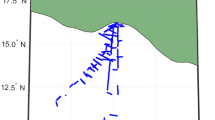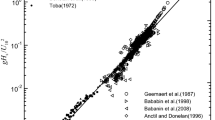Abstract
An analytical expression for the 10 m drag law in terms of the 10 m wind speed at the maximum in the 10 m drag coefficient, and the Charnock constant is presented, which is based on the results obtained from a model of the air-sea interface derived in Bye et al. (2010). This drag law is almost independent of wave age and over the mid-range of wind speeds (5−17 ms−1) is very similar to the drag law based on observed data presented in Foreman and Emeis (2010). The linear fit of the observed data which incorporates a constant into the traditional definition of the drag coefficient is shown to arise to first-order as a consequence of the momentum exchange across the air-sea boundary layer brought about by wave generation and spray production which are explicitly represented in the theoretical model.



Similar content being viewed by others
Notes
The inertial drag coefficient is defined by the drag relation, \(u_{\star } = \sqrt {K_{I}} (u_{1} - u_{2}/\epsilon )\) in terms of u 1 and the surface current speed, u 2, which occurs at the depth 1/(2k 0), where \(\epsilon = \sqrt {(\rho _{1}/\rho _{2})}\) in which ρ 1 and ρ 2 are respectively the density of air and water. K I is a property of the irrotational wave spectrum without recourse to frictional processes and field observations from the fully developed growing wind-wave sea indicate that K I = 0.0015 (Bye and Wolff 2008).
References
Andreas E L, Mahrt L, Vickers D (2012) A new drag relation for aerodynamically rough flow over the ocean. J Atmos Sci 69:2520–2537
Bye JAT, Babanin AV (2009) Wave generation by wind. In: Steele JH, Turekian KK, Thorpe SA (eds) Encyclopedia of ocean sciences, 2nd edn., pp 304–309
Bye J A T, Ghantous M P, Wolff J-O (2010) On the variability of the Charnock constant and the functional dependence of the drag coefficient on wind speed. Ocean Dyn 60:851–860
Bye J A T, Wolff J-O (2004) Prediction of the drag law for air-sea momentum exchange. Ocean Dyn 54:577–580
Bye J A T, Wolff J-O (2008) Charnock dynamics: a model for the velocity structure in the wave boundary layer of the air-sea interface. Ocean Dyn 58:31–42
Foreman R J, Emeis S (2010) Revisiting the definition of the drag coefficient in the marine atmospheric boundary layer. J Phys Oceanogr 40:2325–2332
Garratt J R (1992) The atmospheric boundary layer. Cambridge University Press, Cambridge, p 307
Toba Y (1973) Local balance in the air-sea boundary process III. On the spectrum of wind waves. J Oceanogr Soc Jpn 29:209–220
Wu J (1980) Wind-stress coefficients over sea surface near-neutral conditions - a revisit. J Phys Oceanogr 10:727–740
Acknowledgments
JATB gratefully acknowledged the award of a Fellowship at the Hanse-Wissenschaftskolleg, Delmenhorst, Germany in the first half of 2013 during which this study was carried out in the Institute for Chemistry and Biology of the Sea (ICBM), University of Oldenburg. Helpful comments by two referees, especially with regard to the presentation of the theoretical results, are also gratefully acknowledged.
Author information
Authors and Affiliations
Corresponding author
Additional information
Responsible Editor: Dirk Olbers
Appendix
Appendix
1.1 The derivation of the 10 m drag law
A convenient analytical procedure is to express the various relations in terms of the non-dimensional parameter X = 1/(a u ⋆m ). On substituting X in Eq. 3 using Eq. 6, we obtain the frictional parameter:
in which K I is the inertial drag coefficient, κ is von Kármán’s constant and s = u ⋆/u ⋆m , and where from Eq. 5 evaluated at K 10m using Eq. 6:
in which g is the acceleration of gravity and z 10 = 10 m. Similarly, using Eqs. 1, 2 and 13, we obtain:
and the wave generation parameter:
On substituting for R and B in Eq. 5 and using Eq. 14) to eliminate c 0m , we obtain the following relation for the inverse drag law, u 10(u ⋆), in terms of X:
from which the 10 m drag law (5) is determined. X can be evaluated from Eq. 14) provided that K 10m , and c 0m which depends on sea state, are known. Direct observations of c 0m (or T m ), however, are not generally available. It is, therefore, necessary to use field data at u 10 < u 10m to infer X, as is shown below.
On substituting Eqs. 15) in 14, we obtain:
where \(X^{\prime } = 1/2 [ \ln {c_{0}^{2}}/ 2gs^{2} z_{10} + \kappa /\sqrt {K_{10m}}]\) , and since X≫1, on using the binomial expansion (18) yields approximately:
Hence, X may be evaluated in terms of s, c 0, and K 10m by substituting c 0 in X ′.
The Charnock constant can also be evaluated in terms of X and compared with observations. From the defining relation for the sea surface roughness (z 0), we have \(\ln z_{10}/z_{0} = \kappa /\sqrt {K_{10}}\) and hence from Eq. 9,
which on eliminating K 10 using Eq. 5 yields:
where W = c 0/u ⋆ is the wave age (Bye et al. 2010). On substituting for R from (13), and for W from (15) which yields:
where W m = c o m /u ⋆m is the wave age at the drag coefficient maximum, we obtain,
in which, from Eq. 14:
Finally, on substituting Eqs. 24) in 23, we have the expression for the Charnock constant:
We note that (25), which is independent of c 0m , indicates that the choice of K 10m , rather than u ⋆m or c 0m , is highly significant in the evaluation of α. In terms of X, the spray parameter:
These expressions will be evaluated using the observed estimates at the maximum drag coefficient of K 10m = 0.002 and u 10m = 40 ms−1 (u ⋆m = 1.79 ms−1), and also κ = 4, g = 9.8 ms−2 and K I = 0.0015, and at the onset of wave growth (s = 05) yield from Eq. 17 u 10 = 3.0 ms−1, and, α = 018 in agreement with observations for the fully developed sea (Section 3.2). Note that all these expressions, except for Eqs. 13 and 21 which involve R, are independent of K I .
Rights and permissions
About this article
Cite this article
Bye, J.A.T., Wolff, JO. & Lettmann, K.A. On the variability of the Charnock constant and the functional dependence of the drag coefficient on wind speed: Part II-Observations. Ocean Dynamics 64, 969–974 (2014). https://doi.org/10.1007/s10236-014-0735-4
Received:
Accepted:
Published:
Issue Date:
DOI: https://doi.org/10.1007/s10236-014-0735-4




